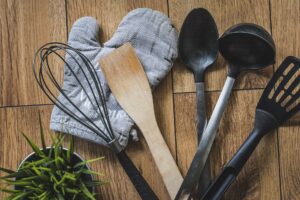When it comes to cooking, the choice of utensils can greatly impact the outcome of your culinary creations. In this article, we will explore the differences between alloy steel and stainless steel cooking utensils. From their various uses and benefits to their pros and cons, we’ll provide you with all the information you need to make an informed decision on which type of cooking utensil is best suited for your needs. So grab your apron and let’s embark on this kitchen adventure together!
Cooking Utensils: Alloy Steel vs. Stainless Steel
This image is the property of images.pexels.com.
Introduction
When it comes to choosing the right cooking utensils, there are many factors to consider. One of the most important decisions is the type of material used in the construction of the utensils. Two popular options are alloy steel and stainless steel. Both materials come with their own unique properties and offer various advantages and disadvantages.
In this article, we will explore the properties of alloy steel and stainless steel cooking utensils, as well as their respective advantages and disadvantages. By the end, you will have a better understanding of which option is best suited for your cooking needs.
Properties of Alloy Steel
Alloy steel is a type of steel that is made by mixing elements such as chromium, nickel, and manganese with regular steel. This combination of elements gives alloy steel its unique properties.
1. Strength
One of the key properties of alloy steel is its strength. Alloy steel has a higher tensile strength and yield strength compared to stainless steel. This makes it more resistant to deformation and allows it to withstand greater weights and pressures without bending or breaking.
2. Hardness
Alloy steel is also known for its hardness. It is harder than stainless steel, which makes it less prone to scratching or denting. This property makes alloy steel utensils highly durable and long-lasting.
3. Wear resistance
Another advantage of alloy steel is its wear resistance. Due to its hardness, alloy steel utensils are less likely to wear down over time, even with frequent use. This makes them ideal for heavy-duty cooking tasks that involve cutting, chopping, or stirring.
4. Heat resistance
Alloy steel exhibits excellent heat resistance properties. It can withstand high temperatures without warping or losing its structural integrity. This makes alloy steel utensils suitable for a wide range of cooking methods, including frying, boiling, and baking.
Advantages of Alloy Steel Cooking Utensils
Now that we have explored the properties of alloy steel, let’s take a look at the advantages of using alloy steel cooking utensils.
1. Durability
The strength and hardness of alloy steel make it highly durable. Alloy steel utensils can withstand the rigors of daily cooking and are less likely to be damaged or worn out compared to other materials. This durability ensures that your utensils will last for years to come.
2. Versatility
Alloy steel utensils are extremely versatile in the kitchen. They can be used for a wide range of cooking methods, including frying, boiling, sautéing, and baking. This versatility makes them a convenient choice for any home cook.
3. Non-reactive
Alloy steel is non-reactive, meaning it does not react with acidic or alkaline foods. This makes it safe to use with all types of ingredients, including tomatoes, citrus fruits, and vinegar. Non-reactive utensils prevent any unwanted flavors or odors from being transferred to your food.
4. Affordable
Compared to stainless steel, alloy steel cooking utensils are generally more affordable. This makes them a budget-friendly option for those who want high-quality utensils without breaking the bank. Alloy steel utensils offer excellent value for money.
Disadvantages of Alloy Steel Cooking Utensils
While alloy steel cooking utensils offer numerous advantages, it’s important to consider their disadvantages as well.
1. Prone to rusting
One of the main drawbacks of alloy steel utensils is that they are prone to rusting. If not properly cared for, alloy steel can develop rust spots, especially when exposed to moisture. Regular cleaning, drying, and proper storage are essential to prevent rusting.
2. Not suitable for acidic foods
While alloy steel is non-reactive, it is not recommended for prolonged use with highly acidic foods. Acidic ingredients can strip away the protective layer of the utensil, increasing the risk of rusting. It’s best to avoid using alloy steel utensils with highly acidic dishes and opt for stainless steel instead.
3. Requires seasoning
Unlike stainless steel, alloy steel utensils require seasoning before initial use and periodic re-seasoning to maintain their non-stick properties. Seasoning involves coating the utensil with a thin layer of oil and heating it to create a protective barrier. This extra step may be time-consuming for some users.
This image is the property of images.pexels.com.
Properties of Stainless Steel
Stainless steel is a type of steel alloy that contains at least 10.5% chromium. This chromium content gives stainless steel its unique properties.
1. Corrosion resistance
One of the most notable properties of stainless steel is its corrosion resistance. The chromium in stainless steel forms a protective layer on the surface, preventing rust and corrosion from developing. This makes stainless steel utensils highly durable and long-lasting.
2. Heat resistance
Stainless steel exhibits excellent heat resistance. It can withstand high temperatures without warping or losing its shape. This makes stainless steel utensils suitable for various cooking methods, including baking, roasting, and broiling.
3. Non-reactive
Similar to alloy steel, stainless steel is non-reactive. It does not react with acidic or alkaline foods, ensuring that the flavors of your dishes remain true. Stainless steel utensils allow you to cook a wide variety of ingredients without any unwanted reactions or aftertastes.
4. Easy to clean
Stainless steel utensils are known for their easy cleaning properties. They are resistant to stains, tarnishing, and discoloration, making them effortless to maintain. A simple wash with soapy water is usually enough to keep stainless steel utensils clean and shiny.
Advantages of Stainless Steel Cooking Utensils
Now let’s delve into the advantages of choosing stainless steel cooking utensils for your kitchen.
1. Durability
Stainless steel utensils are highly durable and resistant to wear and tear. They can withstand heavy use and are less likely to chip, scratch, or dent compared to other materials. Stainless steel utensils are built to last, making them a wise investment for any cookware collection.
2. Hygienic
Stainless steel is a hygienic material for cooking utensils. Its non-porous surface prevents the growth of bacteria, making it a safe choice for food preparation. Stainless steel utensils are easy to clean and do not retain any lingering flavors or odors, ensuring the purity of your dishes.
3. Retains flavors
Unlike some other materials, stainless steel does not react with food or absorb flavors. This means that your dishes will always taste fresh and true when cooked with stainless steel utensils. Stainless steel allows you to achieve the full flavors of your ingredients without any interference.
4. Low maintenance
Stainless steel utensils require minimal maintenance. They are resistant to stains and do not require seasoning. Stainless steel is also dishwasher-safe, making it convenient for those who prefer easy cleanup. The low-maintenance nature of stainless steel utensils saves time and effort in the kitchen.

This image is the property of images.pexels.com.
Disadvantages of Stainless Steel Cooking Utensils
While stainless steel cooking utensils come with numerous advantages, it’s important to consider their disadvantages as well.
1. Poor heat conductivity
One of the main drawbacks of stainless steel utensils is their poor heat conductivity. Stainless steel is not a great conductor of heat, meaning that it takes longer for the utensils to heat up and distribute heat evenly. This can result in uneven cooking or longer cooking times.
2. More expensive
Compared to alloy steel, stainless steel utensils are generally more expensive. The higher cost is due to the corrosion resistance and durability of stainless steel. While the initial investment may be higher, the longevity and performance of stainless steel utensils can make them worth the price.
3. Heavy
Stainless steel utensils tend to be heavier than some other materials, such as aluminum. This can make them more difficult to handle, especially for those who prefer lightweight utensils. However, the weight of stainless steel utensils can also provide stability and balance during cooking.
Comparison of Alloy Steel and Stainless Steel
Now that we have explored the properties and advantages/disadvantages of alloy steel and stainless steel cooking utensils, let’s compare the two materials on various factors.
1. Durability
Both alloy steel and stainless steel are highly durable materials, capable of withstanding heavy use and maintaining their structural integrity. However, alloy steel is known for its exceptional strength and hardness, giving it a slight edge in terms of durability.
2. Heat resistance
Both materials exhibit excellent heat resistance properties, making them suitable for a variety of cooking methods. However, stainless steel has better heat conductivity, ensuring more even heat distribution and faster cooking times compared to alloy steel.
3. Reactivity
Both alloy steel and stainless steel are non-reactive materials, meaning they do not react with acidic or alkaline foods. However, stainless steel is generally considered more resistant to corrosion and is less likely to develop rust spots. Stainless steel is the preferred choice for prolonged use with highly acidic dishes.
4. Maintenance
In terms of maintenance, stainless steel utensils have the advantage. They are easy to clean, resistant to stains, and do not require seasoning. Alloy steel utensils, on the other hand, are prone to rusting and require regular cleaning, drying, and periodic seasoning.

Conclusion
When it comes to choosing between alloy steel and stainless steel cooking utensils, it ultimately depends on your personal preferences and cooking needs. Alloy steel utensils offer exceptional strength and hardness, making them highly durable and versatile. They are a budget-friendly option but require more maintenance and care to prevent rusting.
On the other hand, stainless steel utensils provide excellent corrosion resistance, hygienic properties, and ease of cleaning. While they may be more expensive and have poor heat conductivity, they offer durability, versatility, and low maintenance.
Consider your cooking style, budget, and priorities when making your decision. Whichever material you choose, both alloy steel and stainless steel cooking utensils can enhance your culinary experience and help you create delicious meals. Happy cooking!




